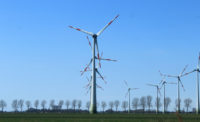When you’re 280 feet off the ground, your feet clinging to the deck, the breeze blowing past, you’ve got a clear view of the power of wind energy. This past summer, I experienced it first-hand.
The New York communities of Lowville and Martinsburg are the home of the 195-turbine Maple Ridge Wind Farm. We checked out the wind farm from a range of angles and perspectives. And, yes, we climbed a turbine.
The mechanics of ascent are simple enough, in theory at least. In our case, we scaled five separate ladder sections inside the tower, most 60 to 80 feet at a stretch, each topped by a platform. We then climbed into the nacelle, the central part of the wind turbine where the hub and blades connect. And then we made our way out the hatch in the ceiling of the nacelle to get on top.
We were never in any danger. The Maple Ridge operators, like wind industry professionals across the country, take safety seriously. We were well educated ahead of time with an instructional video, written materials, and an in-person orientation.
Once on the site, we were harnessed, hooked up, or on solid footing every step, rung, and roof of the way. The harness lets you hook into a cable running up the ladder, so that even if you lose your footing on the way up or down, you don’t go very far. At each platform I shut behind me the hatch I had just come through so I couldn’t go anywhere unintended while transferring my hookup from the ladder cable to rings in the tower wall, to catch my breath and wait for the rest of the group. And before climbing out on top, I hooked into a ring on the roof. Plenty safe.
Some 8,000 components come together in harmony to create a working wind turbine. And with 52,000 turbines now installed in our country, companies in America have assembled that combination of components many, many times.
A single turbine can generate enough electricity to supply hundreds of typical U.S. homes. The 195 turbines at Maple Ridge add up to 322 MW, generating enough electricity to power well over over100,000 homes. On an average single day, the electricity from Maple Ridge would be enough to light more than 50 million light bulbs for the evening.
Nationwide, the 82,000 MW of wind power now gracing US lands supply more than five percent of our electricity, or enough for more than 20 million homes.
Source: John Rogers, senior energy analyst, Clean Energy, posted by the Union of Concerned Scientists


